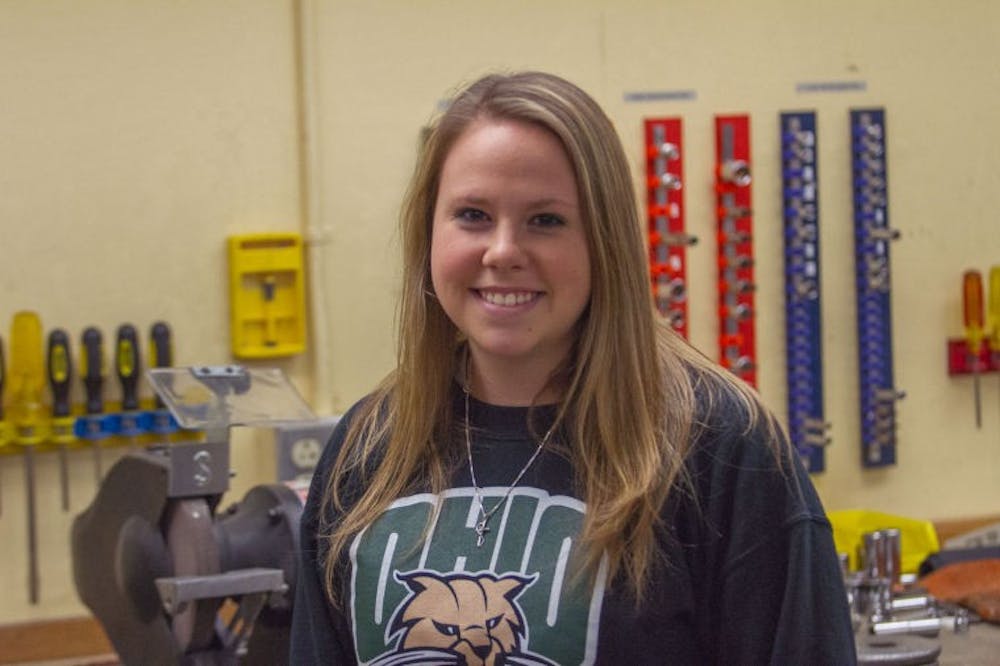Marissa Singley’s professors in the Russ College of Engineering and Technology knew her name within the first week of classes, and it’s not because of her exceptional understanding of the subjects.
Rather, she is one of just 14 women in a graduating class of nearly 300.
Russ is the most male-dominated college at Ohio University, with about 13 percent of its overall student body comprising women. The second most male-dominated college is the College of Business, comprising nearly 30 percent female.
The College of Health Sciences and Professions is the most female-dominated at 74 percent, followed by the College of Education at 72 percent.
Singley, a senior studying mechanical engineering, is the president of both OU’s Society of Women Engineers and the Student Advisory Board of Mechanical Engineers.
Unlike other programs, engineering has historically been male-dominated, a trend slowly changing at OU.
“If you look at the numbers for why … the research points to lack of female role models in engineering,” said Jody Markley, director of multicultural experiences.
Markley, who was appointed to the newly created position last August, works to recruit and mentor women and other minorities in the Russ College.
“You kind of take a multi-pronged approach,” Markley said. “We’re using the resources that we currently have at our disposal to reach all different ages.”
Women accounted for nearly 18 percent of all 2009 undergraduates who studied an engineering program in the United States, according to the National Science Foundation’s website.
In that same year, Russ College saw half of that number: Slightly more than 9 percent undergraduates enrolled in the college were female.
In 2013, that number jumped to about 13 percent at OU — about the same nationally, according to the National Science Foundation from 2011.
The college has devoted resources to recruiting local elementary and middle school students.
“It tends to be at the end of middle school where (girls) drop that interest in engineering,” Markley said.
The Society of Women Engineers hosted an event in February for local Girl Scouts troops, ranging from ages 6 to 14. The girls performed engineering-related tasks, such as building a bridge out of toothpicks, according to a previous Post article.
“I honestly think that it has something to do with personality. … You have to have confidence in yourself,” Singley said. “When people tell you that you can’t do it, you have to have the ability to prove them wrong.”
Organizations, such as the Society of Women Engineers, and scholarships are also used to attract more women, such as the Russ Vision Fund, which stems from a 2008 donation totaling $124 million from the Fritz and Dolores Russ fund.
“For one, we’re significantly targeting our Russ Vision scholarships toward women, and although this isn’t the only reason we recruit outstanding women faculty, we’re always aware that these role models are important for recruiting and retaining talented young women,” said Dennis Irwin, Russ College dean.
The number of females in the Russ College greatly varies per major.
Fields such as chemical and biomolecular engineering tend to have a higher concentration of women, whereas mechanical and electrical engineering numbers have traditionally been low.
“Among the engineering disciplines, chemical engineering has enrolled one of the highest proportions of women for decades,” said Valerie Young, department chair and associate professor of chemical engineering.
Stereotypes are partly to blame for the disparity among majors. Mechanical engineering is often associated with cars, griminess and masculinity, while fields like biomolecular engineering are associated with altruism, cleanliness and femininity, Singley said.
“I have not seen any gender-skewed pattern like this in the employment of our graduates,” Young said. “Both men and women have been about as likely to take jobs in any given sector.”
Singley is set to graduate in May and has a job with General Motors’ power and water division.
“I wouldn’t say that just because you’re a woman, you’re going to get a job,” Singley said. “You have to work hard for it, but you do have that advantage of being a minority.”
@dinaivey
db794812@ohiou.edu






